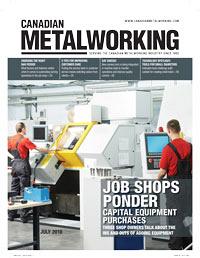Global After Sales Manager
- FMA
- The Fabricator
- FABTECH
- Canadian Metalworking
5 tips for improving customer care
Putting the service back in customer service means soliciting advice from clients
- By Wayne Drysdale
- July 19, 2018
- Article
- Management
Effective aftermarket support is one of the core capabilities of successful manufacturing businesses.
However, if done poorly, it can impact the customer badly, leading to unnecessary downtime. For example, the slow delivery of replacement parts can cost both the vendor and the customer. Loyalty, money, and reputation are all at stake.
If managed properly, a well-performing aftermarket support team can give you a competitive edge. Many manufacturers mention it as a reason why they choose to continue investing in certain machines. Helping customers in many ways helps the manufacturer grow and sustain business.
I would argue that manufacturing companies are becoming more and more like service companies, and any distinct line between the two is getting harder to draw. Manufacturing companies that build high-performing customer service teams will get ahead.
In many ways I am now tasked with much of the responsibility of selling our machines, rather than simply marketing. In my experience, the most effective way to build customer loyalty is by providing excellent aftermarket support, which includes being agile and responding quickly to customer requests. We recently interviewed our customers and after-sales support was by far their No. 1 priority.
Furthermore, technology is transforming how a customer service team operates. Remote diagnostics and preventive maintenance quickly are becoming the norm. This technology shift has made the importance of a quality service team paramount to its customers’ success, ensuring they can minimize machine downtime and maximize production efficiencies.
Add services to your offerings
An obvious place to focus on is after-sales service. For example, providing effective troubleshooting advice, education, and training on how to get the most out of a purchase and finding better ways to provide replacement parts if there is an issue are easy targets for continual improvement.
Service offerings within manufacturing companies can increase revenues, provide differentiation from competitors, and increase the loyalty customers feel. “Providing support generates a low-risk revenue stream over a long period of time,” a group of experts pointed out in Harvard Business Review in 2006. “Aircraft manufacturers, for instance, can reap additional revenues for as long as 25 years after a sale. The longer the life of the asset, the more opportunities companies will find down the line.”
Seizing the opportunities
Machine tool buyers are increasingly expecting things like around-the-clock, unmanned operation and remote diagnostics. A machine breakdown is a critical issue, and 24/7 responses to such an issue are expected.
As technology is enabling better use of an asset, it’s also enabling better service when there are issues. This means offering remote diagnostics and responding to error codes. Remotely logging onto a customer’s machine to explore a problem is also possible.
But we need to continue to offer customers face-to-face support as well to “upskill” them so they get the best use out of their investment.
Customer service also means responding swiftly. It involves a lifetime of support for an asset, regardless of time zone or remoteness. For example, at ANCA this requires a network of more than 60 service technicians and branches in the U.S., Europe, and China. All work in service of a simple goal: being No. 1 in lifetime customer experience.
For all manufacturing companies, the future brings challenges, but also many exciting possibilities. They include internet of things (IoT) concepts for customer support and providing better information to customers on how their assets are being used through sophisticated analytics. The increasing importance of services is likely to continue, and technology will provide new and better ways of solving customers’ problems.
Here are five tips on how to deliver great customer service:
1. Be Responsive
It's important to respond quickly to all inquiries, even if it’s to simply say you are looking into the issue and will get back to the customer. There is nothing worse than non-responsiveness to a customer who is trying to get help.
Customer support response times can dictate how a client perceives your company and can affect the overall customer experience. Keeping your customers informed in a timely manner by answering phone calls and responding to emails within a reasonable time frame are essential to great customer service.
2. Ask for Feedback
You may be surprised by what you learn about your customers’ needs when you ask them what they think of your business, products, and services. Excellent customer service often comes down to consistently checking in with your customers and making sure they are happy with the products and services you're providing.
If you do that successfully, you are on your way to becoming known for providing excellent customer service. Just remember to use the feedback you receive to make improvements where needed.
3. Commit to Continuous Improvement
Ask yourself at the end of the day, “What is the one thing I am going to do tomorrow to make my business better?”
4. Invest in Great People
The quality of your customer service will never exceed the quality of the people providing it. If you plan to outperform the competition, plan on investing heavily in a team that can deliver and treat employees well because there is a distinct correlation between the quality of after-sales service and customer intent to repurchase.
5. Be a Good Listener
Take the time to identify customer needs by asking questions and concentrating on what the customer is really saying. Our customers are the reason we are still in business, and our job is to serve them to the best of our ability.
Good customer service starts with a genuine desire to delight your clients.
Wayne Drysdale is global after sales manager for ANCA, www.anca.com.
About the Author
Related Companies
subscribe now


Keep up to date with the latest news, events, and technology for all things metal from our pair of monthly magazines written specifically for Canadian manufacturers!
Start Your Free Subscription- Industry Events
MME Saskatoon
- May 28, 2024
- Saskatoon, SK Canada
CME's Health & Safety Symposium for Manufacturers
- May 29, 2024
- Mississauga, ON Canada
DiPaolo Machine Tools Open House 2024
- June 4 - 5, 2024
- Mississauga, ON Canada
FABTECH Canada
- June 11 - 13, 2024
- Toronto, ON Canada
Zoller Open House & Technology Days 2024
- June 12 - 13, 2024
- Ann Arbor, MI





















